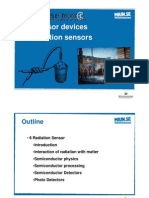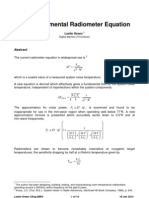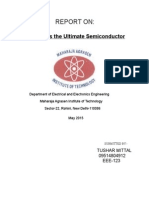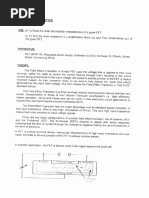Lecture 18 - Light Emitting Diodes - Outline: - Recombination Processes
Uploaded by
Kamal Singh RathoreLecture 18 - Light Emitting Diodes - Outline: - Recombination Processes
Uploaded by
Kamal Singh Rathore6.
772/SMA5111 - Compound Semiconductors
Lecture 18 - Light Emitting Diodes - Outline
Recombination Processes
(continued from Lecture 17)
Radiative vs. non-radiative
Relative carrier lifetimes
Light emitting diode basics
Concepts, operation; the eye and color
Device design challenges; performance metrics
LED practice
(history; LED evolution and revolution)
Early devices
materials
device structures
Fiber coupled devices
Resonant cavity devices
Modern devices
high efficiency, high intensity advances
new material advances
white light sources
C. G. Fonstad, 4/03
(getting heat and light out)
(nitrides)
Lecture 18 - Slide 1
Recombination models: radiative and non-radiative
Radiative recombination rate:
Rrad = rrad (T) n p = B n p
where we have followed the convention of writing the
proportionality factor, rrad(T), as B.
If we assume we have a p-type sample, we define a
radiative lifetime for the minority carriers as:
1
1
n
@
, where we define t rad
Rrad =
Bp Bpo
t rad
Non-radiative recombination rate: Non-radiative
recombination also depends on the np product, but
since it occurs via mid-gap levels it is much less
sensitive to the majority population, p in this case.
Thus we define a non-radiative lifetime as
1
n
, with t non-rad
Rnon-rad = rnon-rad (T) n p = A n =
A
t non-rad
C. G. Fonstad, 4/03
Lecture 18 - Slide 2
Recombination models: net recombination
Net generation/recombination: In thermal equilibrium
generation and recombination balance:
Go = Ro = (rrad + rnon-rad ) n o po = Bpo n o + An o
When we disturb thermal equilibrium by injecting
excess carriers and/or having current, we can have
net generation or recombination, and a population
change:
n 1 J e
+ Go + gext ( x, t ) - Bnp - An
=
t q x
Using our equilibrium relation, we can write this as:
n 1 J e
= gext ( x, t ) - B( np - n o po ) - A(n - n o )
t q x
It is convenient to define excess carrier populations:
n' ( n - n o ), p' ( p - po )
C. G. Fonstad, 4/03
Lecture 18 - Slide 3
Recombination models: net recombination, cont.
With these definitions, we have
n' 1 J e
gext ( x,t ) - [ B( po + p') + A] n'
t q x
To obtain this we assumed quasineutrality, n' p', and
extrinsic p-type, po >> no.
If we assume low-level injection, defined as p' << po,
then we can neglect p' relative to po and write:
n'
n' 1 J e
gext ( x,t ) - [ Bpo + A] n' = gext ( x,t ) t min
t q x
where the minority carrier lifetime is defined as:
1
t min
( Bpo + A)
C. G. Fonstad, 4/03
Lecture 18 - Slide 4
Recombination models: net recombination, cont.
It is important to relate the total minority carrier
lifetime to the radiative and non-radiative lifetimes
we introduced earlier:
1
1
1
+
Bpo + A =
t min
t rad t non-rad
Finally, note that if we have high-level injection, we find
that the lifetime decreases with injection level:
1
t min =
B( po + p') + A
Note also that the it is the radiative lifetime that is
decreasing and thus that the fraction of carriers
recombining radiatively is increasing.
C. G. Fonstad, 4/03
Lecture 18 - Slide 5
Light emitting diodes: current-output relationships
Assume we have an LED where the efficient radiative
emission occurs on the p-side of the device (a typical
situation). The optical power out of this LED is:
n'
dx
Pout = hext Pgenerated = hext hn A
internally
dev t rad
where:
hn: energy per photon
hext:
extraction or external efficiency (the fraction ot
of photons generated that get out)
A: device cross-section area normal to current
and the integral is the total number of photons generated
per unit time in the device.
This integral can be related to the total diode current and
the minority carrier current on the p-side.
C. G. Fonstad, 4/03
Lecture 18 - Slide 6
Light emitting diodes: current-output relationships, cont
We return to:
n'
n' 1 J e
= gext ( x,t ) t min
t q x
In the steady state, with no external generation term
this becomes:
1 J e
n'
=
q x t min
And the integral in the output power equation becomes:
w
1 t min
1 t min w J e
n'
+
J
0
- Je (w p )
dx
=
dx
=
)
o t
e(
o
q t rad
x
q t rad
rad
p
Inserting this, we arrive at:
t
hn
hext A min J e (0 + ) - J e (w p )
Pout =
t rad
q
C. G. Fonstad, 4/03
]
Lecture 18 - Slide 7
Light emitting diodes: current-output relationships, cont
Finally, we recognize that it is useful conceptually to
identify several of the terms in this result as efficiencies.
Doing so we write:
+
A
J
0
- Je (w p ) t
)
e(
iD
iD
min
Pout = hn hext
= hn hext hi hrad
q
iD
t rad
q
where:
hn: energy per photon
hext: extraction or external efficiency (the fraction of
hi:
hrad:
of photons generated that get out)
current efficiency (the fraction of the total diode
current that is current into the p-side of the device and
that recombines there before getting to the contact)
radiative efficiency (the fraction of electron current
that recombines radiatively)
Identifying these efficiencies is useful because doing so
helps us understand how to make the device better. We
will next look at them each in turn, bottom to top
C. G. Fonstad, 4/03
Lecture 18 - Slide 8
Light emitting diodes: radiative efficiency
The radiative efficiency is defined as:
1
1 t rad
t
=
hrad min =
1+ t rad t non-rad
1 t rad + 1 t non-rad
t rad
From this we confirm our intuition that a short
radiative lifetime and long non-radiative lifetime are
best. This is largely a question of using the right
materials, and making sure they are high quality.
We can also write hrad in terms of A and B:
B( po + p')
1
t min
=
=
hrad
1+ A [B( po + p')]
B(
po + p') + A
t rad
from this we see that driving the device to high level
injection may help. (We say "may" because this may also
lead to heating which will reduce the non-radiative lifetime.)
C. G. Fonstad, 4/03
Lecture 18 - Slide 9
Light emitting diodes: radiative efficiency, cont
Material choices:
Direct band gap - the radiative lifetime is much shorter for
direct band gap materials:
B: 10-11 to 10-9 cm3s-1 for direct gap
10-15 to 10-13 cm3s-1 for indirect gap
Sample values:
GaAs: 7.2 x 10-10
Si: 1.8 x 10-15
Ge: 5.25 x 10-14
Common materials:
IR: GaAs, InGaAsP, GaInNAs
Visible: GaAsP, InGaP, InGaAsP, GaN, GaAlInN
Gap level transitions - there are a few examples of useful
radiative transitions via levels in the energy gap
GaP: Zn-O pairs (red)
N-valence band (green)
GaAs: Si-donor to Si-acceptor (980 nm)
C. G. Fonstad, 4/03
Lecture 18 - Slide 10
Light emitting diodes: current efficiency
The current efficiency is the fraction of the total diode
current that is due to the desired minority carriers
(electrons injected into the p-side in the present
example) that recombine before reaching the ohmic
contact:
A
J e (0 + ) - J e ( w p )
hi
iD
We can make the current efficiency approach 100% by
taking the following precautions:
- Use asymmetric doping: this insures injection into
-
the appropriate side of the device
NDn >> NAp
Make the diodes wide: this insures that the carriers
recombine before reaching the contacts
wp << Le
Use heterojunctions: to increase injection efficiency
and to shield carriers for ohmic contacts
C. G. Fonstad, 4/03
Lecture 18 - Slide 11
Light emitting diodes: extraction efficiency
The extraction efficiency, how much of the radiation
actually leaves the device, is the most difficult issue for
many LEDs. There are several contributions:
1. Total internal reflection
2. Internal (re)absorption
3. Blocking by contacts
Because of the refractive index of most semiconductors is
high, 3.5 being a typical value, Item 1 is a major issue.
The critical angle for total internal reflection is only 16
at a semiconductor-to-air boundary. Spontaneous
radiation (which is what we are dealing with) is directed
uniformly in all directions, and the fraction hitting a
flat surface within the critical angle, Qcrit, is:
hex = (sin 2 Q crit ) 4
Evaluating this for n = 3.5, we find that only 2% of
the light can escape the solid!
C. G. Fonstad, 4/03
Lecture 18 - Slide 12
Light emitting diodes: fighting total internal reflection
Total internal reflection can be alleviated if the device is
packaged in a domed shaped, high index plastic
package:
If the device is fabricated with a substrate that is
transparent to the emitted radiation, then light can
be extracted from the 4 sides and bottom of the
device as well as from the top. This increases the
extraction efficiency by a factor of 6!
C. G. Fonstad, 4/03
Lecture 18 - Slide 13
Light emitting diodes: fighting total internal reflection, cont.
Other solutions to the total internal reflection that are not
as widely used as these are:
Thin devices with roughened surfaces: The idea is that if
there is very little internal (re)absorption of the emitted light,
the light will bounce around inside the device until it hits the
surface at an angle within the critical angle. If the surface is
rough, the chance of this happening is increased.
Resonant cavity LEDs: If a one-dimensional photonic
crystal (a distributed Bragg reflector) is placed on the bottom
of the device, the light emitted downward will be redirected up.
Superluminescent emitting LEDs: If a device is driven
strongly enough, there can be some stimulated emission, and
this will be highly directed, as we shall see when we talk about
laser diodes. This can be used to increase an LEDs emission.
None of these ideas work as well as using a transparent substrate,
collecting the light from all sides of a device, and putting the
device in a high-index package positioned in a suitable reflector.
C. G. Fonstad, 4/03
Lecture 18 - Slide 14
Light emitting diodes: historical perspective
LEDs are a very old device, and were the first commercial
compound semiconductor devices in the marketplace.
Red, amber, and green LEDs (but not blue) were sold in
the 1960's, but main research focus was on laser diodes,
and little LED research was done after the 1970's.
Things changed dramatically in the 1990's,
in part because of new materials developed in the search
for red and blue lasers, InGaP/GaAs, GaInAlN/GaN
in part because of packaging innovations,
improved heat sinking and advanced reflector designs
in part due to advances in wafer bonding, and
transparent substrates for improved light extraction
in part due to the diligence of LED researchers.
taking advantage of advances in other fields
C. G. Fonstad, 4/03
Lecture 18 - Slide 15
III-V quarternaries:
InGaAsP
Early GaAsP red
LEDs grown on
linearly graded
buffer on GaAs
Modern InGaAlP
red LEDs grown
lattice-matched
on GaAs, and
transferred to
GaP substrates
C. G. Fonstad, 2/03
Lecture 1 - Slide 16
The III-V wurtzite quarternary:
GaInAlN
AlN
0.2
6.0
0.25
5.0
0.3
4.0
GaN
0.4
3.0
0.5
2.0
0.6
0.7
InN
1.0
0.28
C. G. Fonstad, 2/03
0.30
0.34
0.36
0.32
Lattice period, a (nm)
0.38
Lecture 1 - Slide 17
Light emitting diodes typical specta
LED emission - typ. 20 nm wide
Important spectra for
comparison with LED
spectrum
C. G. Fonstad, 4/03
Lecture 18 - Slide 18
Light emitting diodes - human eye response
700
v: Luminous flux (lm)
600
500
400
610 nm
510 nm
300
C. G. Fonstad, 4/03
400
450
500
550
600
Red
Orange
Yellow
Blue
Green
100
Violet
200
650
700
Lecture 18 - Slide 19
750
Light emitting diodes - Red and Amber LEDs
Red LEDs
Yellow/Amber LEDs
C. G. Fonstad, 4/03
Lecture 18 - Slide 20
Light emitting diodes - Conventional green LEDs; Burrus-type
Green LEDs
LED designed to
couple efficiently
to a fiber (Burrus
geometry)
C. G. Fonstad, 4/03
Lecture 18 - Slide 21
You might also like
- Unit-Iv Optical Source, Detectors and Amplifiers: Popular Semiconductors Used For Led FubricationNo ratings yetUnit-Iv Optical Source, Detectors and Amplifiers: Popular Semiconductors Used For Led Fubrication19 pages
- Diode Operation: 97.398, Physical Electronics, Lecture 8No ratings yetDiode Operation: 97.398, Physical Electronics, Lecture 821 pages
- Light Emitting Diodes (Leds) : Ele 432 Assignment # 3 Vijay Kumar PeddintiNo ratings yetLight Emitting Diodes (Leds) : Ele 432 Assignment # 3 Vijay Kumar Peddinti14 pages
- ChaptedOPANT dIFFUSION 7 Dopant Diffusion - INo ratings yetChaptedOPANT dIFFUSION 7 Dopant Diffusion - I32 pages
- Lect11-Semiconductor Lasers and Light-Emitting DiodesNo ratings yetLect11-Semiconductor Lasers and Light-Emitting Diodes182 pages
- Introduction To Interferometry - Lee - UnknownNo ratings yetIntroduction To Interferometry - Lee - Unknown21 pages
- Principles and Applications of Electrical Engineering 5th Edition Rizzoni Solutions Manual download100% (1)Principles and Applications of Electrical Engineering 5th Edition Rizzoni Solutions Manual download69 pages
- Progress in Electromagnetics Research, Vol. 120, 83-97, 2011No ratings yetProgress in Electromagnetics Research, Vol. 120, 83-97, 201115 pages
- Form Factors Grey Bodies and Radks Course PDFNo ratings yetForm Factors Grey Bodies and Radks Course PDF179 pages
- Light Emitting Diodes (Leds) : Ele 432 Assignment # 3 Vijay Kumar PeddintiNo ratings yetLight Emitting Diodes (Leds) : Ele 432 Assignment # 3 Vijay Kumar Peddinti14 pages
- Optical Fibers and Waveguides: Chapter SeventeenNo ratings yetOptical Fibers and Waveguides: Chapter Seventeen38 pages
- Sensor Devices Sensor Devices Radiation SensorsNo ratings yetSensor Devices Sensor Devices Radiation Sensors53 pages
- Gain Optimization of A Multi-Layer Printed Dipole Array Using Evolutionary ProgrammingNo ratings yetGain Optimization of A Multi-Layer Printed Dipole Array Using Evolutionary Programming4 pages
- OPTICAL FIBER COMMUNICATION Basic and CharactersticsNo ratings yetOPTICAL FIBER COMMUNICATION Basic and Characterstics36 pages
- Light Emitting Diode - Design Principles: EBB 424ENo ratings yetLight Emitting Diode - Design Principles: EBB 424E32 pages
- Progress in Electromagnetics Research M, Vol. 27, 219-229, 2012No ratings yetProgress in Electromagnetics Research M, Vol. 27, 219-229, 201211 pages
- Lab 3: The Quantization of Light and Plancks Constant: 1 Photoelectic Effect ApparatusNo ratings yetLab 3: The Quantization of Light and Plancks Constant: 1 Photoelectic Effect Apparatus8 pages
- Physics Investigatory Project: Light Emitting Diode (Led)No ratings yetPhysics Investigatory Project: Light Emitting Diode (Led)18 pages
- Statistical Mechanics Lasers and Fiber OpticsNo ratings yetStatistical Mechanics Lasers and Fiber Optics35 pages
- Electrostatic Precipitators: (Mihelcic & Zimmerman, Section 12.8.4 + Added Material)No ratings yetElectrostatic Precipitators: (Mihelcic & Zimmerman, Section 12.8.4 + Added Material)10 pages
- 9.5 P-I-N Photodiode:: Module 9: Photo Detectors Lecture: PhotodiodesNo ratings yet9.5 P-I-N Photodiode:: Module 9: Photo Detectors Lecture: Photodiodes6 pages
- Second Order Low-Pass and High-Pass Filter Designs Using Method of Synthetic Immittance ElementsNo ratings yetSecond Order Low-Pass and High-Pass Filter Designs Using Method of Synthetic Immittance Elements6 pages
- ME 457 Experimental Solid Mechanics (Lab) Photoelasticity ExperimentNo ratings yetME 457 Experimental Solid Mechanics (Lab) Photoelasticity Experiment8 pages
- 2.626 Fundamentals of Photovoltaics: Mit OpencoursewareNo ratings yet2.626 Fundamentals of Photovoltaics: Mit Opencourseware31 pages
- Radiosity Computer Graphics: Advancing Visualization through Radiosity in Computer VisionFrom EverandRadiosity Computer Graphics: Advancing Visualization through Radiosity in Computer VisionNo ratings yet
- Method of Moments for 2D Scattering Problems: Basic Concepts and ApplicationsFrom EverandMethod of Moments for 2D Scattering Problems: Basic Concepts and ApplicationsNo ratings yet
- VBA Code To Unlock A Locked Excel Sheet - 4 StepsNo ratings yetVBA Code To Unlock A Locked Excel Sheet - 4 Steps3 pages
- Apeejay Stya University, Sohna, Gurgaon: Course Code: ETEC-208No ratings yetApeejay Stya University, Sohna, Gurgaon: Course Code: ETEC-2081 page
- Apeejay Stya University, Sohna, Gurgaon: Course Code: ETEC-208No ratings yetApeejay Stya University, Sohna, Gurgaon: Course Code: ETEC-2081 page
- Apeejay Stya University, Sohna, Gurgaon: Course Code: ETEC-208No ratings yetApeejay Stya University, Sohna, Gurgaon: Course Code: ETEC-2081 page
- Instrumentation and Measurement: Csci 599 Class Presentation Shreyans MehtaNo ratings yetInstrumentation and Measurement: Csci 599 Class Presentation Shreyans Mehta22 pages
- PJ2N9013 NPN Epitaxial Silicon Transistor: 1W Output Amplifier of Potable Radios in Class B Push-Pull OperationNo ratings yetPJ2N9013 NPN Epitaxial Silicon Transistor: 1W Output Amplifier of Potable Radios in Class B Push-Pull Operation3 pages
- Irf244, Irf245, Irf246, Irf247: 14A and 13A, 275V and 250V, 0.28 and 0.34 Ohm, N-Channel Power MosfetsNo ratings yetIrf244, Irf245, Irf246, Irf247: 14A and 13A, 275V and 250V, 0.28 and 0.34 Ohm, N-Channel Power Mosfets8 pages
- KSP44 / KSP45 NPN Epitaxial Silicon Transistor: FeaturesNo ratings yetKSP44 / KSP45 NPN Epitaxial Silicon Transistor: Features8 pages
- M/odeling Body: Self-Consistent of - Ultra Le Mo4SfetNo ratings yetM/odeling Body: Self-Consistent of - Ultra Le Mo4Sfet4 pages
- Sem-I Chapter-2 Electricity, Magnetism & Semiconductors-OutputNo ratings yetSem-I Chapter-2 Electricity, Magnetism & Semiconductors-Output101 pages
- Electronics For Starters 2 - TransistorsNo ratings yetElectronics For Starters 2 - Transistors4 pages
- Unit-Iv Optical Source, Detectors and Amplifiers: Popular Semiconductors Used For Led FubricationUnit-Iv Optical Source, Detectors and Amplifiers: Popular Semiconductors Used For Led Fubrication
- Diode Operation: 97.398, Physical Electronics, Lecture 8Diode Operation: 97.398, Physical Electronics, Lecture 8
- Light Emitting Diodes (Leds) : Ele 432 Assignment # 3 Vijay Kumar PeddintiLight Emitting Diodes (Leds) : Ele 432 Assignment # 3 Vijay Kumar Peddinti
- Lect11-Semiconductor Lasers and Light-Emitting DiodesLect11-Semiconductor Lasers and Light-Emitting Diodes
- Principles and Applications of Electrical Engineering 5th Edition Rizzoni Solutions Manual downloadPrinciples and Applications of Electrical Engineering 5th Edition Rizzoni Solutions Manual download
- Progress in Electromagnetics Research, Vol. 120, 83-97, 2011Progress in Electromagnetics Research, Vol. 120, 83-97, 2011
- Light Emitting Diodes (Leds) : Ele 432 Assignment # 3 Vijay Kumar PeddintiLight Emitting Diodes (Leds) : Ele 432 Assignment # 3 Vijay Kumar Peddinti
- Gain Optimization of A Multi-Layer Printed Dipole Array Using Evolutionary ProgrammingGain Optimization of A Multi-Layer Printed Dipole Array Using Evolutionary Programming
- OPTICAL FIBER COMMUNICATION Basic and CharactersticsOPTICAL FIBER COMMUNICATION Basic and Characterstics
- Light Emitting Diode - Design Principles: EBB 424ELight Emitting Diode - Design Principles: EBB 424E
- Progress in Electromagnetics Research M, Vol. 27, 219-229, 2012Progress in Electromagnetics Research M, Vol. 27, 219-229, 2012
- Lab 3: The Quantization of Light and Plancks Constant: 1 Photoelectic Effect ApparatusLab 3: The Quantization of Light and Plancks Constant: 1 Photoelectic Effect Apparatus
- Physics Investigatory Project: Light Emitting Diode (Led)Physics Investigatory Project: Light Emitting Diode (Led)
- Electrostatic Precipitators: (Mihelcic & Zimmerman, Section 12.8.4 + Added Material)Electrostatic Precipitators: (Mihelcic & Zimmerman, Section 12.8.4 + Added Material)
- 9.5 P-I-N Photodiode:: Module 9: Photo Detectors Lecture: Photodiodes9.5 P-I-N Photodiode:: Module 9: Photo Detectors Lecture: Photodiodes
- Second Order Low-Pass and High-Pass Filter Designs Using Method of Synthetic Immittance ElementsSecond Order Low-Pass and High-Pass Filter Designs Using Method of Synthetic Immittance Elements
- ME 457 Experimental Solid Mechanics (Lab) Photoelasticity ExperimentME 457 Experimental Solid Mechanics (Lab) Photoelasticity Experiment
- 2.626 Fundamentals of Photovoltaics: Mit Opencourseware2.626 Fundamentals of Photovoltaics: Mit Opencourseware
- Radiosity Computer Graphics: Advancing Visualization through Radiosity in Computer VisionFrom EverandRadiosity Computer Graphics: Advancing Visualization through Radiosity in Computer Vision
- Method of Moments for 2D Scattering Problems: Basic Concepts and ApplicationsFrom EverandMethod of Moments for 2D Scattering Problems: Basic Concepts and Applications
- Apeejay Stya University, Sohna, Gurgaon: Course Code: ETEC-208Apeejay Stya University, Sohna, Gurgaon: Course Code: ETEC-208
- Apeejay Stya University, Sohna, Gurgaon: Course Code: ETEC-208Apeejay Stya University, Sohna, Gurgaon: Course Code: ETEC-208
- Apeejay Stya University, Sohna, Gurgaon: Course Code: ETEC-208Apeejay Stya University, Sohna, Gurgaon: Course Code: ETEC-208
- Instrumentation and Measurement: Csci 599 Class Presentation Shreyans MehtaInstrumentation and Measurement: Csci 599 Class Presentation Shreyans Mehta
- PJ2N9013 NPN Epitaxial Silicon Transistor: 1W Output Amplifier of Potable Radios in Class B Push-Pull OperationPJ2N9013 NPN Epitaxial Silicon Transistor: 1W Output Amplifier of Potable Radios in Class B Push-Pull Operation
- Irf244, Irf245, Irf246, Irf247: 14A and 13A, 275V and 250V, 0.28 and 0.34 Ohm, N-Channel Power MosfetsIrf244, Irf245, Irf246, Irf247: 14A and 13A, 275V and 250V, 0.28 and 0.34 Ohm, N-Channel Power Mosfets
- KSP44 / KSP45 NPN Epitaxial Silicon Transistor: FeaturesKSP44 / KSP45 NPN Epitaxial Silicon Transistor: Features
- M/odeling Body: Self-Consistent of - Ultra Le Mo4SfetM/odeling Body: Self-Consistent of - Ultra Le Mo4Sfet
- Sem-I Chapter-2 Electricity, Magnetism & Semiconductors-OutputSem-I Chapter-2 Electricity, Magnetism & Semiconductors-Output





































































































